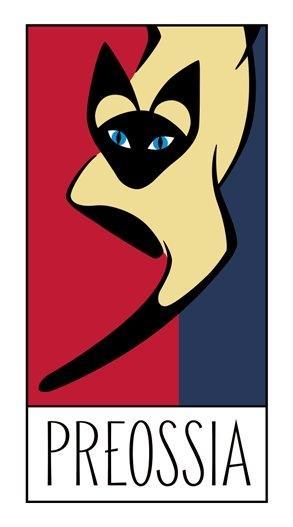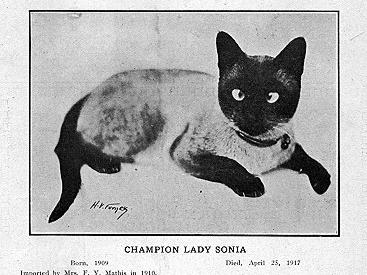For details about the ancestors of our pedigreed Siamese cats, we
have to examine written records, photographs, and eye-witness testimony describing
the earliest English Siamese. Photographs of most of the cats did not survive
to the present day. The few surviving 19th century photos show relatively
robust, round-cheeked cats that in the 20th century became known colloquially
as "applehead" Siamese, though their heads were not truly round.
The earliest British Siamese breeders had only a few imported Siamese
on which to base their opinions. Nonetheless, many of the breeders believed
that there were two body builds or "types" of Siamese. For example, as quoted
in Simpson (1903), Mrs. Carew Cox, a cat show judge and "pioneer of the
Siamese fancy," said:
There appear to be two distinct types—the compactly built, short in body,
short on legs, and round in head; and the long-bodied, long-faced, lithe,
sinuous, and peculiarly foreign-looking variety.
|
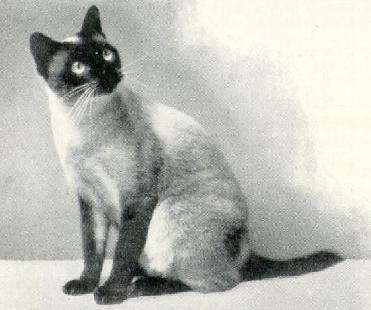 |
| Ah Choo. This lovely seal point female was born in
1900 and bred by Lady Vyvyan. |
Mrs. Robinson an early Siamese breeder and cat judge, is quoted by Simpson
as saying:
Of the royals there seem to be two types in England: the one—rather a small,
longheaded cat, with glossy, close-lying coat and deep blue eyes, and with
a decided tendency to darken with age—is generally the imported cat or having
imported parents; the other is a larger cat, with a rounder head, a much
thicker, longer, and less close-lying coat, and the eyes a paler blue (these
cats do not darken as much or as soon as the other type, and have generally
been bred for several generations in England).
After reading what Mrs. Robinson had to say, we might wonder if the authentic,
purebred Siamese cats from Siam were all as slinky and pointed as the show-style
Siamese of today. We might wonder if the "applehead" Siamese is strictly
a Western phenomenon, the result of hybridization of imported Siamese with
the heftier, fluffier native British cats. However, Mrs. Robinson's imported
stud, Champion Wankee, was considered a fine example of a Siamese for his
time, and he was one of the imported cats that presumably Mrs. Robinson was
talking about. He did have a distinct muzzle and a long body. This was not
a round-skulled or compact cat. Yet clearly Champion Wankee would be considered
an "applehead" by today's standards. See photo directly below.
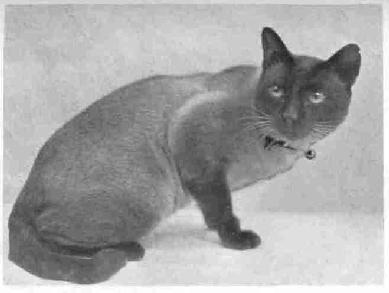
Mrs. Robinson's Champion Wankee
Testimony of other early breeders also indicates that many or most
of the earliest imported Siamese were heftier and rounder than the show-style
Siamese of today. For example, Mrs. Veley, who owned two of the original
imported Siamese, wrote that her imported queen Mia was the rounder, heavier
type, and her imported stud Pho was the slimmer, lither type (Franklin, 1995).
It is well documented that Pho and Mia were brought back from Siam by Mrs.
Veley's brother, the vice consul. Many authors have also claimed that these
cats, both round Mia and slim Pho, were gifts of the king of Siam, but there
is no hard evidence to support that, and in fact there is no evidence that
any Siamese were ever bred by the king of Siam (Clutterbuck, 1998; Dunnill,
1974; Denlinger, 1952).
Returning to Mrs. Veley's allegedly round Siamese Mia and slim Siamese
Pho, let's look at their kittens. One surviving photo of Mia's and Pho's
kittens shows robust, round-cheeked babies with wedge-shaped muzzles (see
below). The appearance of the kittens suggests that Mrs. Veley may have been
describing moderate, relative differences in the body types of her cats, not
extreme differences. If Pho had been as extremely Oriental in body type as
the show-style Siamese of today, we would expect his kittens out of Mia to
be at least a little more extreme than the ones you see here. Mrs. Veley was
also probably over-generalizing from her own two cats. Most likely the early
British Siamese breeders were reading too much into the variation they saw
in their tiny population of Siamese breeding cats. Based on what we know now
in the 21st century about feline genetics, it is unlikely that there were
two distinct types of Siamese. Probably there were varying degrees of variation
in body type from Siamese cat to Siamese cat. It appears that most of the
early Siamese, perhaps all of them, would have been considered "appleheads"
by today's standards. The earliest Western Siamese were on average more moderate
and substantial in type than the show-style Siamese of the current era.
Incidentally, by doing a little "linechasing" (pedigree research),
either on the Web or by conventional means, it's easy to demonstrate that
Pho and Mia were among the eleven imported Siamese cats that became the
ancestors of all Western pedigreed Siamese alive today.

Kittens produced by Pho & Mia, the legendary Siamese
said to have
been gifts from the king of Siam.
Siamese cats continued to be imported by English breeders into the
early 20th century. In the 1910s, Greta Hindley and her husband were living
in Malaya, the peninsula that included what is now Malaysia and part of
Thailand. When they returned to England in 1919, they brought with them
two Siamese cats, including a queen named Puteh. Puteh was the foundation
of the famous Prestwick Cattery Siamese. Puteh's daughter, Champion Prestwick
Perak, was described by Greta Hindley as having the perfect head shape for
a Siamese cat (Franklin, 1995). Photos of Perak and of the other early Prestwick
Cattery cats show that although they had wedge-shaped heads and lithe, Oriental
bodies, they were still appreciably larger of bone and less extreme than
the show-style Siamese of today. (For photos to compare, see for example:
Lauder, 1950; Dunnill, 1974; Franklin, 1995).
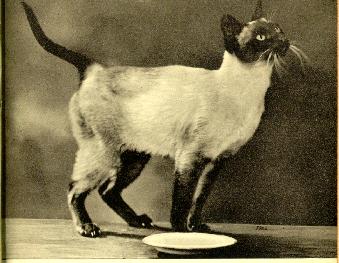
Champion Prestwick Perak, 1920s
In fact, the majority of surviving early photos of the Siamese cats
from the first few generations reveal that they were more robust and had
more rounded, wedge-shaped heads than today's show-style Siamese. (See, for
example, the photos in Simpson, 1903, and Wade, 1934.) Some early Siamese
were rounder and more robust than others, but all were longer of body and
wedgier of head than the cobby British Shorthairs and Persians of that time
or today. This is probably why the Father of the Cat Fancy, Harrison Weir,
wrote a Siamese breed standard in 1892 that described a marten-faced, Oriental
type of cat distinctly different from the cobby, round British cats.
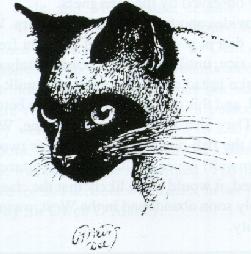
Engraving of Siamese
from Our Cats and All About Them,
by Harrison Weir, 1889
In short, we do not know what all of the founding cats of the Siamese
breed in the West looked like. We have only a limited number of surviving
historical photos available to us. But we know for certain that many of the
original imported Siamese and their first-generation descendants were moderately
wedge-headed, moderately Oriental-style cats of a much more robust, more
substantial, rounder, and less extreme type than the modern Siamese.
There were many published versions of the Siamese breed standard from
the late 19th century to the present. All of those standards could nowadays
be interpreted as describing either the Old-Style Siamese or the modern,
show-style Siamese because the wording was relative rather than absolute.
But a head that was long and marten-faced in 1889 and when compared
with the Persians and British domestics of that period, would not be considered
long and wedge-shaped by today's 21st century standards and when compared
with the much larger range of pedigreed cats bred today. Examine the engraving
of the Siamese used to illustrate Harrison Weir's description of the Siamese
in 1889 (above). The cat in that engraving was drawn by Weir himself. Harrison
Weir, considered today to be the Father of the Cat Fancy, was well known
for his knowledge of, and careful observation of, the cats of his time. Weir
was also an experienced illustrator. His drawing shows a cat that is not
the same as the show-style Siamese of today. It is also noteworthy that Weir
described the Siamese wedge as beginning at eye level, at the muzzle, rather
than from the ears downward as it does now. He described a marten face,
not a marten head.
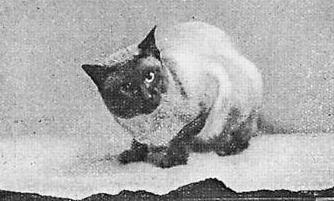
Champion Prince Souti, born 1912. He was
descended from Tiam O'Shian I. Tiam was one
of the original British imports from Siam.
Judging from numerous historic photos, the development of the breed
to a more extreme Oriental type took place gradually beginning just after
World War II. There were no obvious changes in the published breed standard
accompanying this trend. In CFA, the major change in the breed standard was
actually not in the standard per se but in the preface to the standard that
explains how the standard should be interpreted. In 1966, a new preface to
the CFA breed standard was written in which the selective breeding of the
Siamese was compared to nature's molding of the cheetah (Burns, 1993). Breeders
were heralded as artists creating a new work of art. This 1966 preface favored
a more extreme type of Siamese. The ultra-Oriental modern Siamese by then
was beginning to dominate show circles. It was subsequently bred in ever-increasing
numbers and the shift toward a more extreme body type became apparent even
in most pet quality Siamese by approximately 1980. Nevertheless, some of
the remaining moderate Siamese from the 1960s were preserved and their descendants
still exist today. These we call the Old-Style Siamese.
Alderton, David. Cats. New York: Dorling Kindersley, Inc., 1992,
page 18.
Baker, Hettie Gray. Your Siamese Cat. New York: Farrar, Straus
& Young, 1951.
Burns, Barbara S. All About Siamese Cats. Neptune City, NJ: TFH
Publications, 1993.
Clutterbuck, Martin. The Legend of Siamese Cats. Bangkok, Thailand:
White Lotus Press, 1998.
Denlinger, Milo G. The Complete Siamese Cat. New York: Howell
Book House, 1952.
Dunnill, Mary. The Siamese Cat Owner's Encyclopedia. New York:
Howell Book House, 1974.
Franklin, Sally. The Complete Siamese. New York: Howell Book House,
1995.
Lauder, Phyllis. Siamese Cats. London: Williams & Norgate,
1950.
Naples, Marge. This is the Siamese Cat. Jersey City, NJ: TFH Publications,
1964.
Naples, Marge. Siamese Cats. Neptune City, NJ: TFH Publications,
1989.
Simpson, Frances. The Book of the Cat. London: Cassell and Company,
1903.
Van der Meid, Louise. Siamese Cats. Neptune City, NJ: TFH Publications,
1978.
Wade, Phyl. The Siamese Cat. London: Methuen & Company, 1934.
